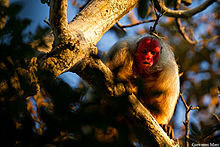Bald Uakari
| Bald uakari | |
|---|---|
 |
|
| Cacajao calvus calvus | |
| Scientific classification | |
| Kingdom: | Animalia |
| Phylum: | Chordata |
| Class: | Mammalia |
| Order: | Primates |
| Family: | Pitheciidae |
| Genus: | Cacajao |
| Species: | C. calvus |
| Binomial name | |
|
Cacajao calvus (I. Geoffroy, 1847) |
|
 |
|
| species range | |
The bald uakari (Cacajao calvus) or bald-headed uakari is a small New World monkey characterized by a very short tail; bright, crimson face; a bald head; and long coat. The bald uakari is restricted to várzea forests and other wooded habitats near water in the western Amazon of Brazil and Peru.
There are four recognized subspecies of the bald uakari, each of which is considered vulnerable to extinction:
The bald uakari weighs between 2.75 and 3.45 kg (6.1 and 7.6 lb), with head and body lengths average 45.6 cm (18.0 in) (male) and 44.0 cm (17.3 in) (female). In general, the bald uakari has a long, shaggy coat ranging from white in color to red and its head is bald. The tail is bob-like and rather short for a New World monkey (about 5.9 inches (15 cm)), at only half the length of the body and head combined. Its scarlet red face is due to the lack of skin pigments and plentiful capillaries that run under its facial tissue.
The arboreal bald uakari prefers to reside in seasonally flooded forests in the area of the Amazon River Basin, in the countries of Peru and Brazil. It is important that the uakari is arboreal (lives in the tree tops) because of the flooding of the forests and the water rising to great heights during the rainy season. During the dry season, it returns to the ground to look for seeds and other food material. A study of the diet of the uakari found it to consist of 67% seeds, 18% fruit, 6% flowers, 5% animal prey, and buds. Its powerful lower jaw forms a pseudodental comb, which allows the uakari to open the hard surfaces of unripe fruits and eat the nuts that most other primates would not be able to open. It will also eat insects that happen to cross its path, however it does not specifically pursue this type of food.
The bald uakari can be found traveling up to 4.8 kilometers per day in multi-male/multi-female groups of 5 to 30 individuals, and even up to 100. It can be extrapolated from the general primate behavior of female philopatry that female uakaries are also philopatric. This means that males leave the natal group. The total size of the group's home range is between 500 and 600 hectares. This requires efficient territorial defense mechanisms. A few of these include specific vocalizations, wagging of the tail, and erection of the hair.
...
Wikipedia

